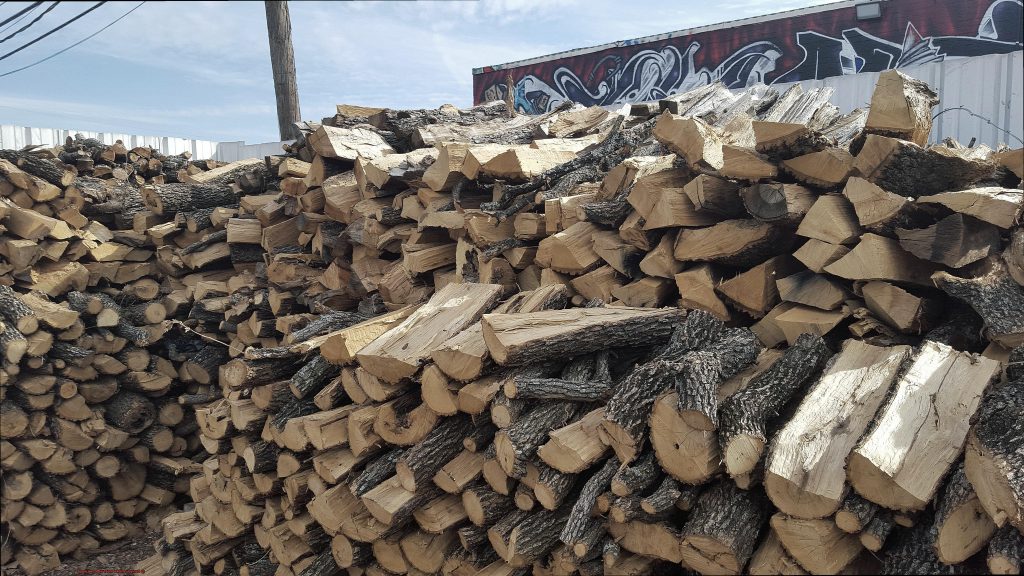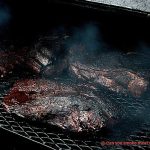Do you crave the irresistible taste of smoked meat? If so, you’re not alone. Smoking meat is an art form that requires skill, patience, and the right equipment. But what about the wood used to smoke the meat? Should you use hardwoods like oak or hickory, or can tree wood like apple or cherry do the job just as well?
In this blog post, we’ll explore the mystery surrounding smoking meat with tree wood. We’ll dive into its benefits and debunk some common myths and misconceptions.
The aroma of smoked meat is enough to make your mouth water. It’s no wonder why it’s a favorite among food enthusiasts worldwide. However, achieving that perfect smoky flavor isn’t easy. It takes a certain level of expertise and patience. But don’t worry; we’ve got you covered.
Throughout this post, we’ll answer the burning question: Can you smoke meat with tree wood? And if so, what type of tree wood is best for smoking meat? We’ll guide you through everything from choosing the right wood to using it correctly.
So sit back, relax, and get ready to learn all about smoking meat with tree wood.
Contents
The Benefits of Smoking Meat with Tree Wood
If you’re looking for a way to elevate your meat-grilling game, look no further than smoking with tree wood. This centuries-old technique offers a variety of benefits that charcoal or gas simply can’t match.
One major advantage of smoking with tree wood is the unparalleled flavor it imparts on your meat. Each type of tree wood has its own unique flavor profile, ranging from sweet to savory, giving your meat a depth of flavor that can’t be replicated by other methods. Hickory wood, for example, produces a bold and smoky flavor that pairs perfectly with beef or pork, while fruitwoods like apple and cherry provide a milder, sweeter flavor that works well with poultry and fish.
Another benefit of using tree wood as fuel for smoking is that it’s a natural and organic option. Charcoal and gas can contain chemicals and additives, but tree wood is entirely natural and free from harmful substances. This makes it an ideal choice for those who prioritize healthy eating and want to avoid synthetic ingredients in their food.
Smoking meat with tree wood is also an environmentally friendly option. Instead of contributing to pollution and waste like other fuel sources, using tree wood reduces the carbon footprint of grilling and smoking. Plus, it supports sustainable forestry practices by utilizing wood that would otherwise go to waste.
And let’s not forget about the affordability factor. Many types of tree wood are readily available and can be purchased at a reasonable price point, making it accessible for all grill enthusiasts.
Different Types of Tree Wood for Smoking Meat
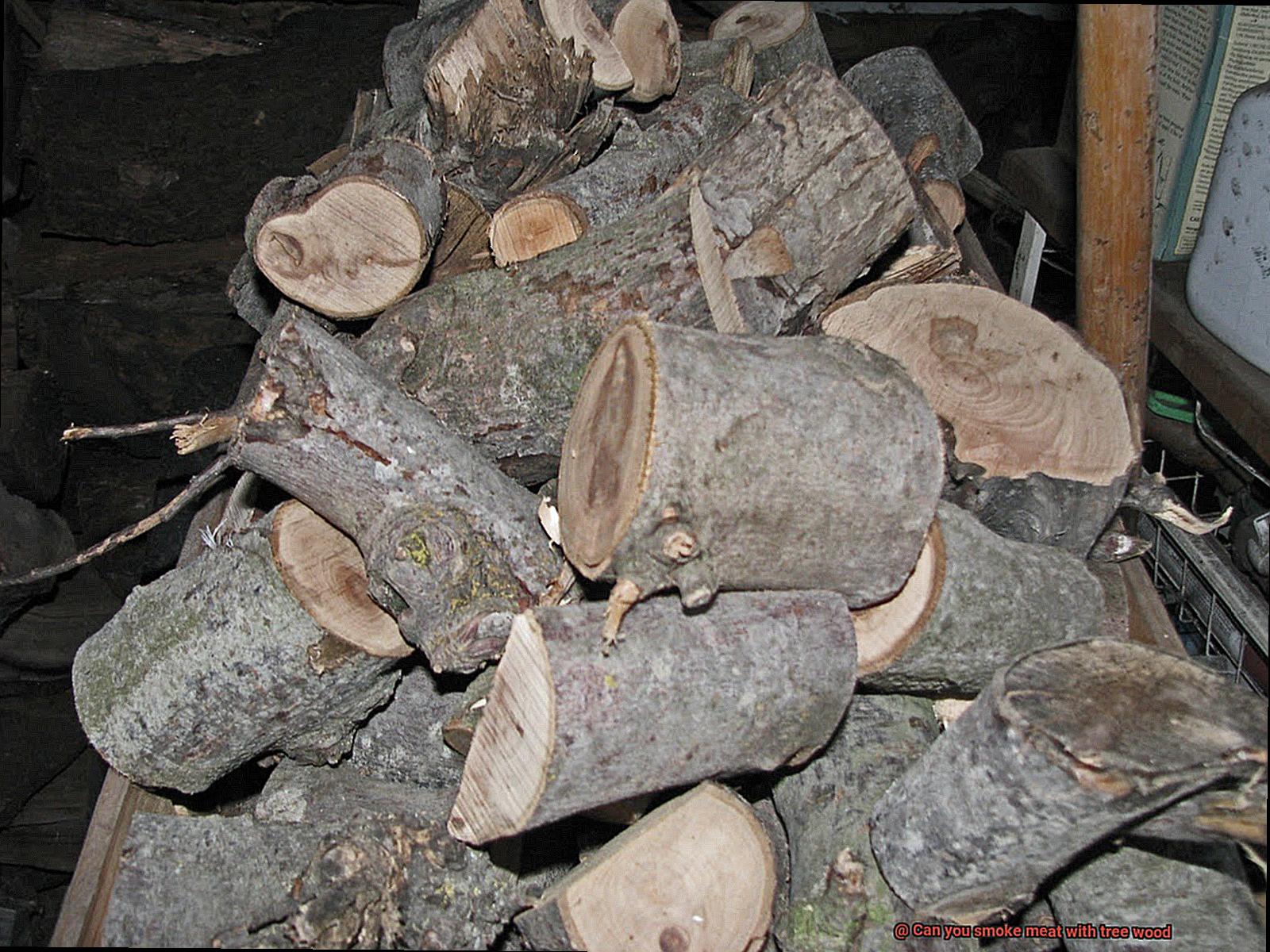
Smoking meat with tree wood is a time-honored tradition that has been used for centuries to add flavor and depth to meat. However, not all tree woods are created equal when it comes to smoking meat. In this blog post, we will explore the different types of tree wood that can be used for smoking meat and the flavor profiles they impart.
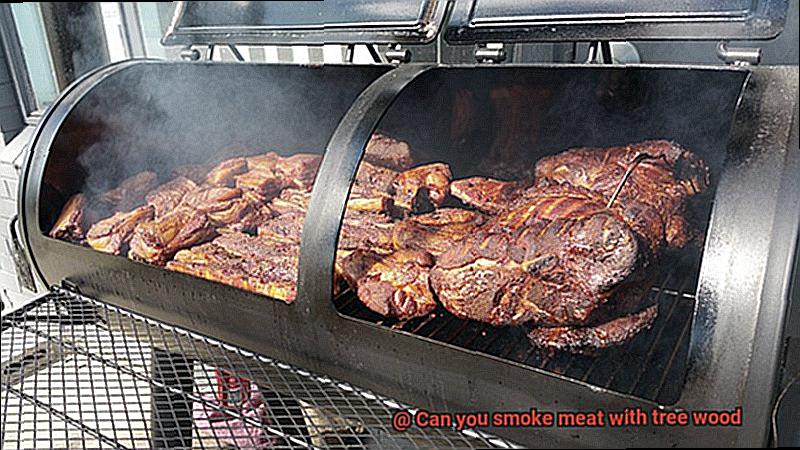
Hickory Wood
Hickory wood is a popular and versatile choice for smoking meat because of its strong, bold flavor. Hickory pairs well with beef, pork, and game meats, and can be used for both hot and cold smoking. The strong flavor of hickory can be overpowering if used in large amounts, so it’s best to use it in moderation or mix it with other woods for a more complex flavor profile.
Mesquite Wood
Mesquite wood has a distinctively sweet and smoky flavor that is perfect for smoking beef and game meats. However, its potency means that it should be used sparingly, as it can easily overpower the meat if used in large amounts.
Fruit Woods
Fruit woods like apple and cherry are milder in flavor and work well with poultry and fish. Applewood imparts a sweet and fruity flavor that is subtle yet distinctive, while cherry wood is similar in terms of its mild flavor profile. These fruit woods work well when used alone or in combination with other woods to create a more complex flavor.
Oak Wood
Oak wood has a strong smoky flavor that works well with all types of meat, particularly beef. It’s also a great choice if you’re looking to use wood as a fuel source for your smoker, as it burns hot and long. Oak’s strong flavor makes it an excellent base wood for creating custom blends with milder woods like fruitwoods or pecan.
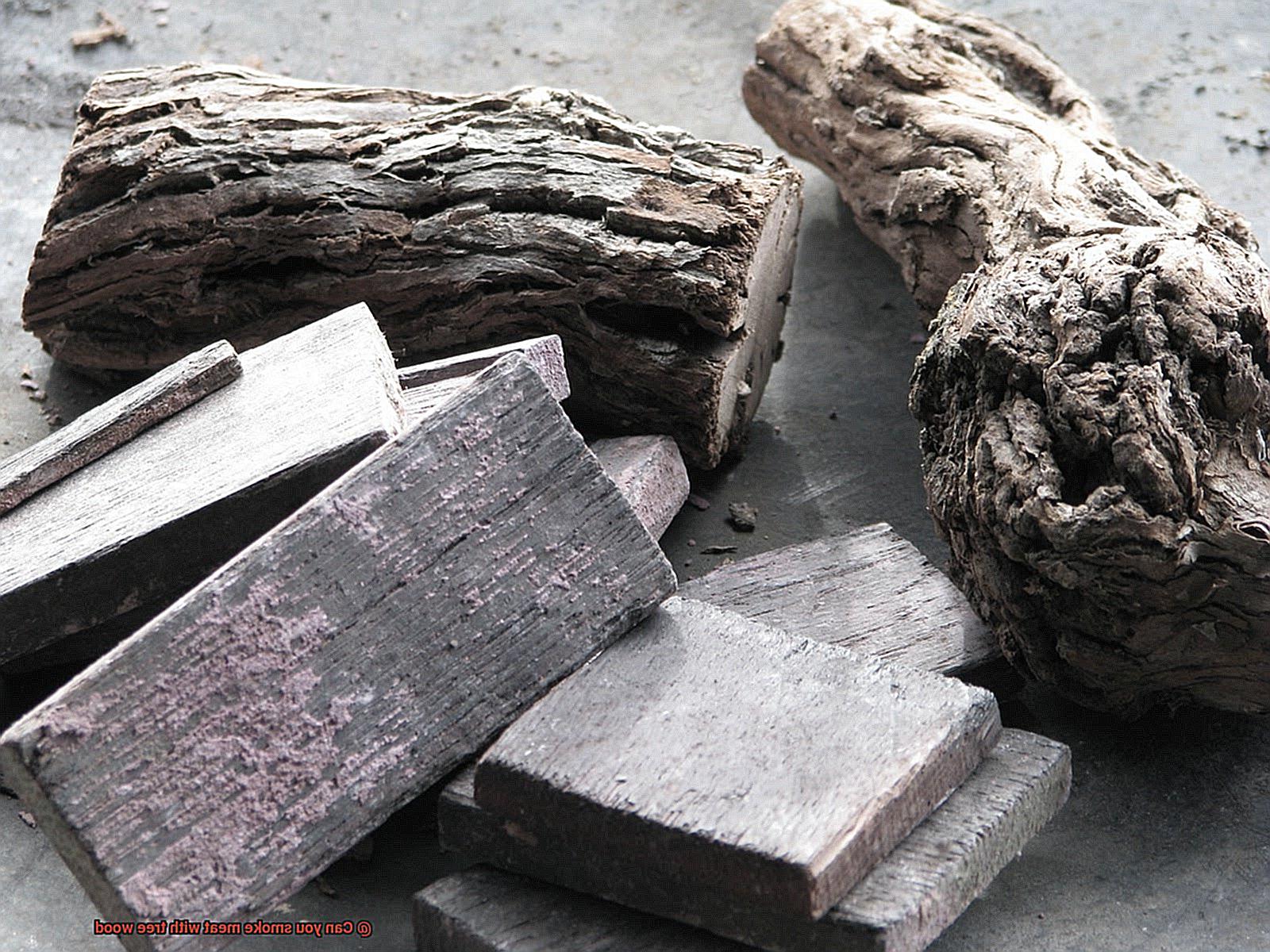
Other Types of Tree Wood
Maple, pecan, alder, and cedar are other types of tree wood that can be used for smoking meat. Each type of wood offers its own unique flavor profile and can be used to create a variety of delicious smoked meats. Maple has a sweet and subtle flavor that works well with poultry, while pecan has a nutty, rich flavor that pairs well with pork and poultry. Alder is mild and slightly sweet, making it a good choice for fish, and cedar has a strong aroma that is perfect for smoking salmon.
Determining the Right Type of Tree Wood for Your Needs
Smoking meat with tree wood is a time-honored tradition that can elevate your culinary creations to the next level. But with so many different types of wood to choose from, how do you determine the best one for your needs? Let’s explore the world of tree wood and discover which types will impart the perfect flavor and aroma to your smoked meats.
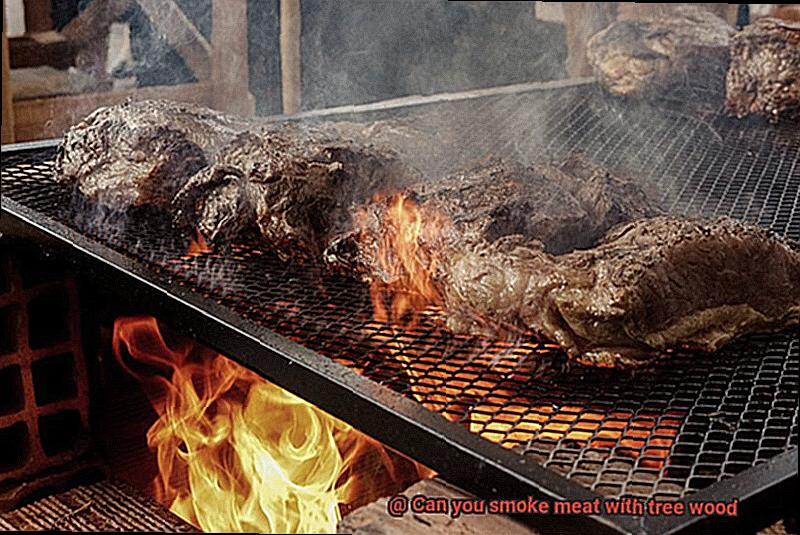
First up is hickory, a go-to choice for many pitmasters. Hickory has a bold, smoky flavor that pairs perfectly with red meats like beef and pork. It’s also a great option for poultry and fish, adding a rich depth of flavor to these lighter meats.
If you’re looking for something a little more unique, mesquite wood might be just what you need. This wood has an earthy flavor that works particularly well with beef, pork, and game meats. However, it can be quite powerful if used in large amounts, so it’s best to blend it with milder woods or use it sparingly.
For those who prefer a sweeter taste, applewood is a popular choice. Its sweet, fruity flavor complements pork and poultry exceptionally well. It can even lend a touch of sweetness to beef dishes.
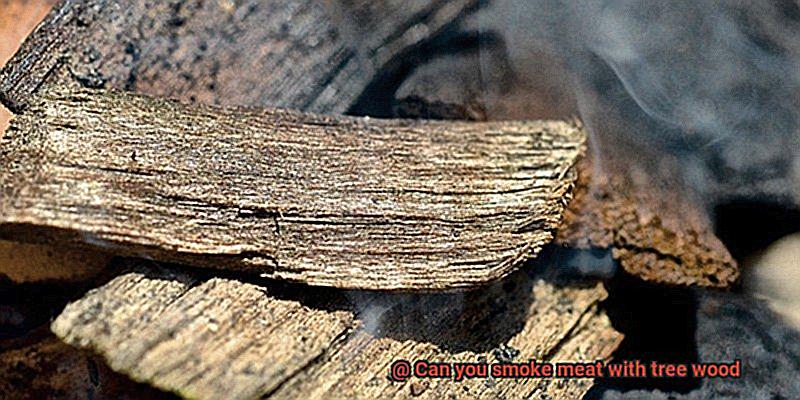
Cherry wood is another fantastic option for smoking meat. It has a mild, sweet flavor that enhances the natural flavors of poultry and pork without overpowering them.
But don’t stop there. The world of tree wood is vast and varied. Oak is a versatile choice that pairs well with all types of meat, while maple has a delicate sweetness that’s perfect for bacon and ham. Pecan adds a distinct nutty flavor that works wonders with chicken and turkey, while alder has a light sweetness that’s ideal for fish. And cedar imparts its own smoky taste that’s perfect for oily fish like salmon.
How to Choose the Best Tree Wood for Smoking Meat
If you want to impress your guests with the perfect smoked meat, choosing the right type of tree wood is crucial. Here are five factors to consider:
Type of Meat
Different types of meat pair well with specific types of wood. For example, hickory is great for smoking pork, while mesquite is ideal for beef. Consider the protein you’re smoking and choose the wood accordingly.
Hardwoods vs. Softwoods
Hardwoods like oak, maple, and cherry are ideal for smoking meat because they burn slowly and produce consistent heat. Softwoods like pine and cedar should be avoided because they contain high levels of resin and sap that can create a bitter taste.
Density
Dense woods like hickory, oak, and mesquite burn slower and hotter than lighter woods such as fruitwoods (apple, cherry, peach) or alder. This makes them perfect for larger cuts of meat that require longer cooking times, like brisket or pork shoulder.
Moisture Content
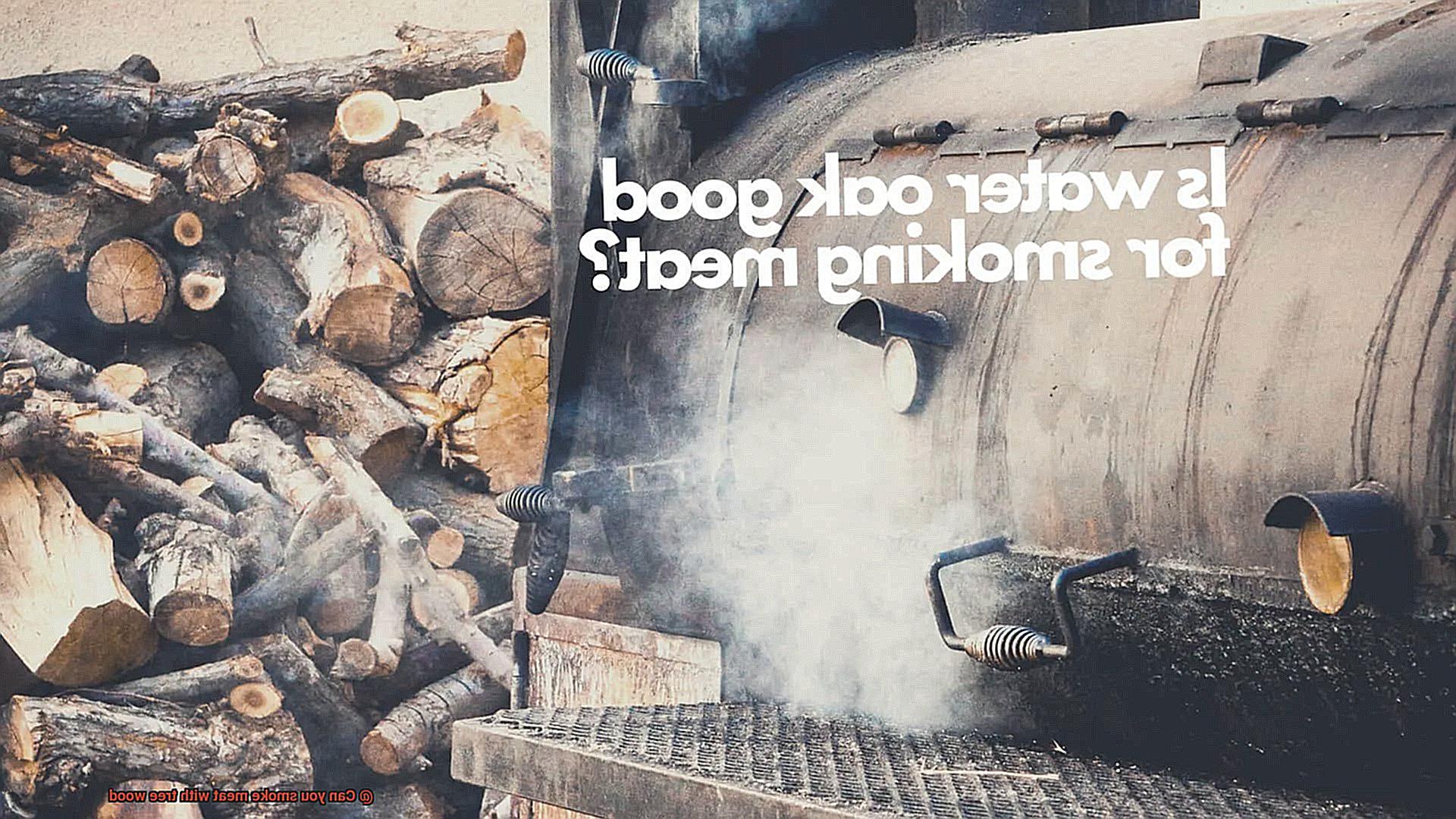
Wet or green wood can produce too much smoke, which can result in a bitter flavor. It’s best to use seasoned or dry wood that has been aged for at least six months before using it for smoking.
Experimentation
Don’t be afraid to experiment with different combinations of woods to find your own unique flavor. Popular choices include hickory, oak, mesquite, applewood, cherrywood, and pecan wood.
Preparing and Lighting Your Firewood for Smoking
Smoking meat is an art form, and the quality of your finished product depends on the materials and techniques you use. Preparing and lighting your firewood may seem like a small step, but it’s crucial to achieving the desired flavor and texture of your smoked meat. In this guide, we’ll take a closer look at why preparing and lighting your firewood for smoking is so important and provide you with some tips to help you become a pitmaster extraordinaire.
The first step to preparing your firewood is to make sure that it’s dry and seasoned. Wet or green wood will create too much smoke, resulting in an unpleasant acrid taste that can ruin the flavor of your meat. The best way to season your wood is to cut it into small pieces and stack it in a dry place with good airflow. This process can take several months, but trust us, it’s worth the wait for the perfect flavor.
Once your firewood is seasoned, it’s time to light your fire. Avoid using lighter fluid or other chemicals that can leave a residue on your smoker and affect the taste of your meat. Instead, use a chimney starter or electric starter to get things going. When your wood has caught fire and is producing smoke, add it to your smoker in small amounts to avoid overpowering the meat with too much smoke.
Monitoring the temperature of your fire is also essential for achieving perfect smoked meat. Use a thermometer to keep an eye on the temperature and adjust the amount of wood you add as needed. Maintaining consistency in temperature is crucial for even cooking without losing tenderness.
Here are some tips for preparing and lighting your firewood for smoking:
- Cut your wood into small pieces that can easily fit into your smoker
- Remove any bark or debris from the wood to prevent unwanted flavors
- Stack the wood in a dry place with good airflow to allow it to season properly
- Use a chimney starter or electric starter to light your fire
- Add small amounts of wood to your smoker to avoid overpowering the meat with too much smoke
- Monitor the temperature of your fire using a thermometer and adjust the amount of wood you add as needed
Tips for Getting the Most Out of Your Smoked Meats
Smoking meat with tree wood is an art form that can elevate your dishes to new heights. However, it can also be a tricky process that requires some finesse. Here are some tips for getting the most out of your smoked meats when using tree wood:
Choose the Right Wood
Not all tree woods are created equal when it comes to smoking meats. Some woods, like oak and hickory, are great for smoking beef and pork, while fruit woods like apple and cherry are better suited for poultry and fish. Make sure you research the different types of wood before choosing one for your meat.
Soak Your Wood
Soaking your wood in water for at least 30 minutes before using it will help prevent it from burning too quickly and producing too much smoke. This will also help create a more consistent temperature throughout the smoking process.
Control the Temperature
Smoking meats with tree wood requires a lower temperature than other cooking methods, so it’s important to keep a close eye on the temperature of your smoker. Use a thermometer to monitor the internal temperature of your meat and adjust the temperature of your smoker accordingly.
Use a Rub
A good rub will not only add flavor to your meat but also help create a crust on the outside that will hold in moisture and prevent the meat from drying out during the smoking process.
When it comes to making a rub, there are countless combinations you can try depending on your personal taste preferences. Some popular ingredients include salt, pepper, paprika, garlic powder, onion powder, cayenne pepper, and brown sugar. Don’t be afraid to experiment with different flavors until you find one you love.
Let it Rest
Once your meat is finished smoking, let it rest for at least 10-15 minutes before slicing into it. This will allow the juices to redistribute throughout the meat, making it more tender and flavorful.
Common Mistakes to Avoid When Smoking Meat with Tree Wood
These mistakes can lead to poor results and even ruin your meat. But fear not, by avoiding these mistakes, you can ensure that your smoked meat with tree wood turns out delicious every time.
Firstly, using green wood is a big no-no. It might be tempting to use freshly cut wood, but trust me when I say it’s a mistake. Green wood hasn’t had time to dry out and can produce excess smoke, which can lead to a bitter taste in your meat. To avoid this, opt for seasoned wood that has been allowed to dry for several months. This will provide a smoother flavor profile that won’t overpower your meat.
Another mistake is using softwoods like pine or cedar. While they might seem like good options, they contain high levels of resin that can create an unpleasant flavor in your meat. Instead, choose hardwoods like oak, hickory, or fruitwoods like apple or cherry. These woods offer a more subtle flavor that will complement your meat without overpowering it.
Oversmoking is another common mistake that can ruin your meat. While smoke adds flavor, too much smoke can mask the natural flavors of the meat and make it taste bitter. Finding the right balance between adding flavor and not overpowering the meat is key to making delicious smoked meat.
Temperature control is also crucial when smoking with tree wood. If the temperature is too high, it can burn the wood too quickly and produce too much smoke. If the temperature is too low, it can cause the meat to dry out and become tough. Always monitor and adjust the temperature throughout the smoking process to ensure your meat comes out perfectly every time.
e_ihPPARY9A” >
Conclusion
In conclusion, smoking meat with tree wood is a revered tradition that can elevate the flavor of your culinary creations to new heights. The benefits of using tree wood for smoking are endless – from its unparalleled taste to its natural and organic options, eco-friendliness, and affordability. Each type of tree wood offers a unique flavor profile ranging from sweet to savory, so it’s crucial to choose the right wood for the meat you’re smoking.
To achieve the desired flavor and texture of your smoked meat, proper preparation and lighting of your firewood are essential. Soaking your wood in water before use prevents it from burning too quickly and producing an excessive amount of smoke. Moreover, controlling the temperature throughout the smoking process is vital to avoid oversmoking or drying out the meat.
While there are common mistakes to avoid when smoking meat with tree wood – such as using green or softwoods or oversmoking – experimenting with different combinations of woods can lead to discovering new and unique flavors. By following these tips and avoiding common mistakes, you can become a pitmaster extraordinaire who impresses guests with perfectly smoked meats every time.

